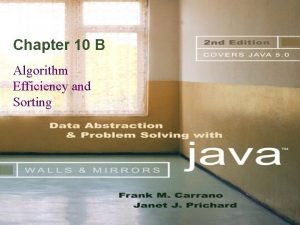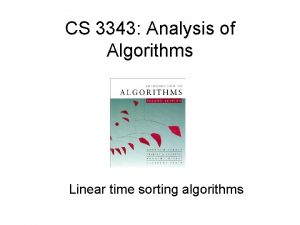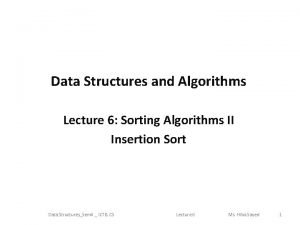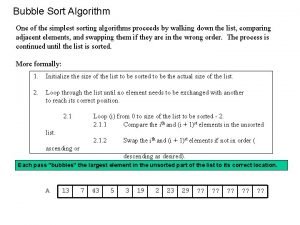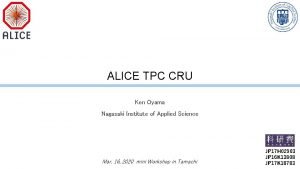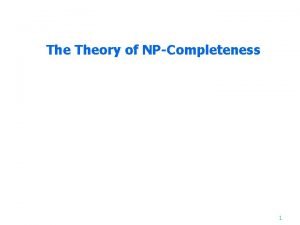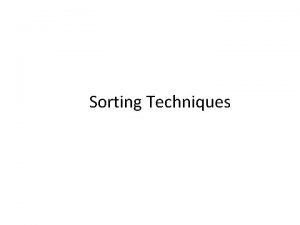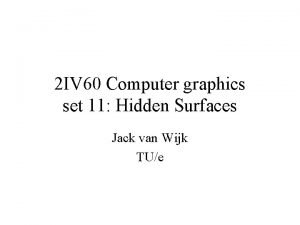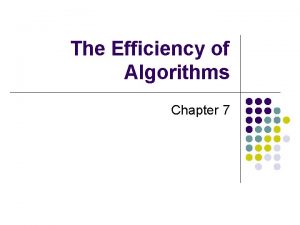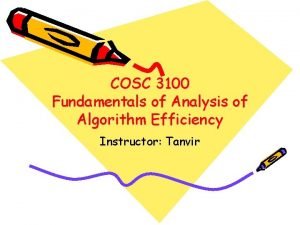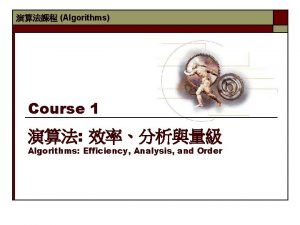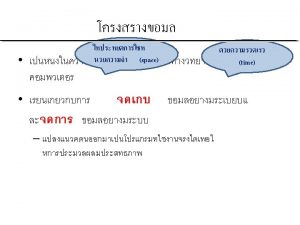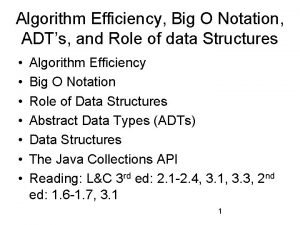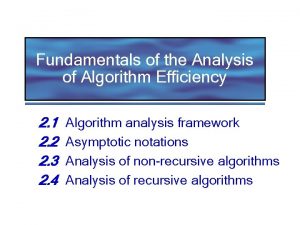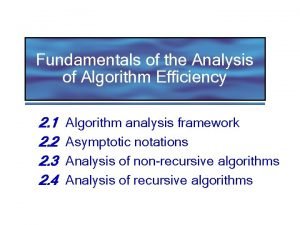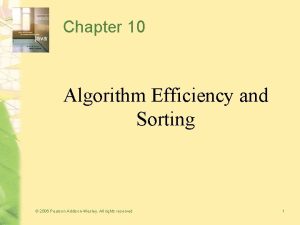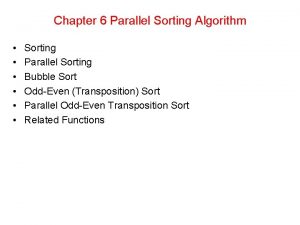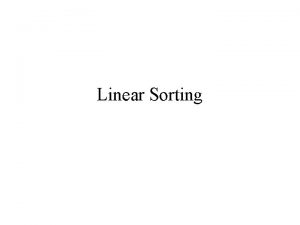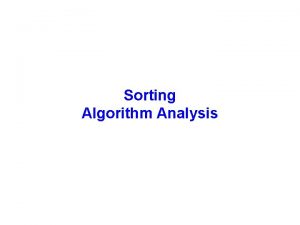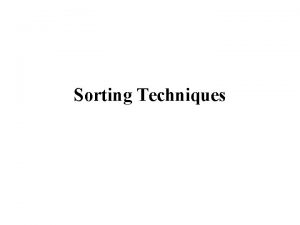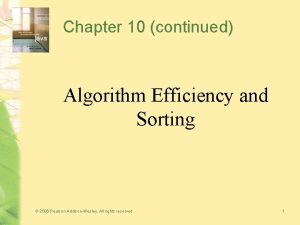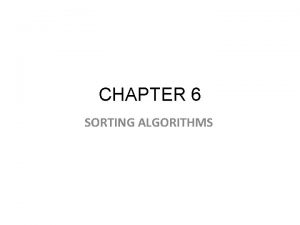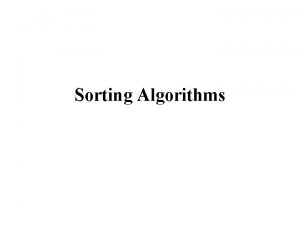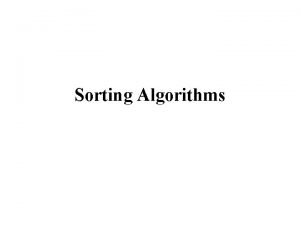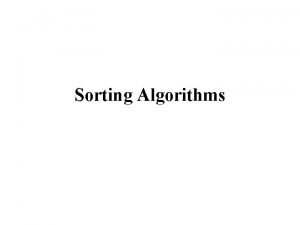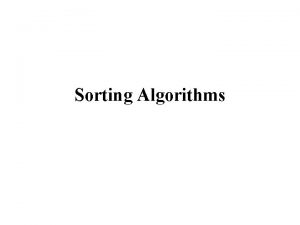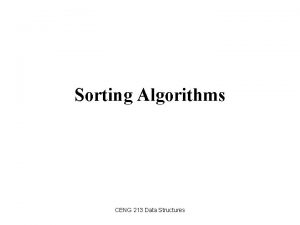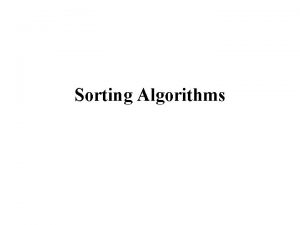Chapter 10 Algorithm Efficiency and Sorting 2006 Pearson





















- Slides: 21

Chapter 10 Algorithm Efficiency and Sorting © 2006 Pearson Addison-Wesley. All rights reserved 1

Measuring the Efficiency of Algorithms • Analysis of algorithms – Provides tools for contrasting the efficiency of different methods of solution • A comparison of algorithms – Should focus of significant differences in efficiency – Should not consider reductions in computing costs due to clever coding tricks © 2006 Pearson Addison-Wesley. All rights reserved 2

Measuring the Efficiency of Algorithms • Three difficulties with comparing programs instead of algorithms – How are the algorithms coded? – What computer should you use? – What data should the programs use? • Algorithm analysis should be independent of – Specific implementations – Computers – Data © 2006 Pearson Addison-Wesley. All rights reserved 3

The Execution Time of Algorithms • Counting an algorithm's operations is a way to access its efficiency – An algorithm’s execution time is related to the number of operations it requires – Examples • Traversal of a linked list • The Towers of Hanoi • Nested Loops © 2006 Pearson Addison-Wesley. All rights reserved 4

Algorithm Growth Rates • An algorithm’s time requirements can be measured as a function of the problem size • An algorithm’s growth rate – Enables the comparison of one algorithm with another – Examples Algorithm A requires time proportional to n 2 Algorithm B requires time proportional to n • Algorithm efficiency is typically a concern for large problems only © 2006 Pearson Addison-Wesley. All rights reserved 5

Algorithm Growth Rates Figure 10 -1 Time requirements as a function of the problem size n © 2006 Pearson Addison-Wesley. All rights reserved 6

Order-of-Magnitude Analysis and Big O Notation • Definition of the order of an algorithm A is order f(n) – denoted O(f(n)) – if constants k and n 0 exist such that A requires no more than k * f(n) time units to solve a problem of size n ≥ n 0 • Growth-rate function – A mathematical function used to specify an algorithm’s order in terms of the size of the problem • Big O notation – A notation that uses the capital letter O to specify an algorithm’s order – Example: O(f(n)) © 2006 Pearson Addison-Wesley. All rights reserved 7

Order-of-Magnitude Analysis and Big O Notation Figure 10 -3 a A comparison of growth-rate functions: a) in tabular form © 2006 Pearson Addison-Wesley. All rights reserved 8

Order-of-Magnitude Analysis and Big O Notation Figure 10 -3 b A comparison of growth-rate functions: b) in graphical form © 2006 Pearson Addison-Wesley. All rights reserved 9

Order-of-Magnitude Analysis and Big O Notation • Order of growth of some common functions O(1) < O(log 2 n) < O(n * log 2 n) < O(n 2) < O(n 3) < O(2 n) • Properties of growth-rate functions – You can ignore low-order terms – You can ignore a multiplicative constant in the highorder term – O(f(n)) + O(g(n)) = O(f(n) + g(n)) © 2006 Pearson Addison-Wesley. All rights reserved 10

Order-of-Magnitude Analysis and Big O Notation • Worst-case and average-case analyses – An algorithm can require different times to solve different problems of the same size • Worst-case analysis – A determination of the maximum amount of time that an algorithm requires to solve problems of size n • Average-case analysis – A determination of the average amount of time that an algorithm requires to solve problems of size n © 2006 Pearson Addison-Wesley. All rights reserved 11

Keeping Your Perspective • Throughout the course of an analysis, keep in mind that you are interested only in significant differences in efficiency • When choosing an ADT’s implementation, consider how frequently particular ADT operations occur in a given application • Some seldom-used but critical operations must be efficient © 2006 Pearson Addison-Wesley. All rights reserved 12

Keeping Your Perspective • If the problem size is always small, you can probably ignore an algorithm’s efficiency • Weigh the trade-offs between an algorithm’s time requirements and its memory requirements • Compare algorithms for both style and efficiency • Order-of-magnitude analysis focuses on large problems © 2006 Pearson Addison-Wesley. All rights reserved 13

The Efficiency of Searching Algorithms • Sequential search – Strategy • Look at each item in the data collection in turn, beginning with the first one • Stop when – You find the desired item – You reach the end of the data collection © 2006 Pearson Addison-Wesley. All rights reserved 14

The Efficiency of Searching Algorithms • Sequential search – Efficiency • Worst case: O(n) • Average case: O(n) • Best case: O(1) © 2006 Pearson Addison-Wesley. All rights reserved 15

The Efficiency of Searching Algorithms • Binary search – Strategy • To search a sorted array for a particular item – Repeatedly divide the array in half – Determine which half the item must be in, if it is indeed present, and discard the other half – Efficiency • Worst case: O(log 2 n) • For large arrays, the binary search has an enormous advantage over a sequential search © 2006 Pearson Addison-Wesley. All rights reserved 16

Sorting Algorithms and Their Efficiency • Sorting – A process that organizes a collection of data into either ascending or descending order • Categories of sorting algorithms – An internal sort • Requires that the collection of data fit entirely in the computer’s main memory – An external sort • The collection of data will not fit in the computer’s main memory all at once but must reside in secondary storage © 2006 Pearson Addison-Wesley. All rights reserved 17

Sorting Algorithms and Their Efficiency • Data items to be sorted can be – Integers – Character strings – Objects • Sort key – The part of a record that determines the sorted order of the entire record within a collection of records © 2006 Pearson Addison-Wesley. All rights reserved 18

Selection Sort • Selection sort – Strategy • Select the largest item and put it in its correct place • Select the next largest item and put it in its correct place, etc. Figure 10 -4 A selection sort of an array of five integers © 2006 Pearson Addison-Wesley. All rights reserved 19

Selection Sort • Analysis – Selection sort is O(n 2) • Advantage of selection sort – It does not depend on the initial arrangement of the data • Disadvantage of selection sort – It is only appropriate for small n © 2006 Pearson Addison-Wesley. All rights reserved 20

Please open file carrano_ppt 10_B. ppt to continue viewing chapter 10. © 2006 Pearson Addison-Wesley. All rights reserved 21
 Internal vs external sorting
Internal vs external sorting Efficiency of sorting algorithms
Efficiency of sorting algorithms Complexity of algorithm
Complexity of algorithm Productive inefficiency and allocative inefficiency
Productive inefficiency and allocative inefficiency Productively efficient vs allocatively efficient
Productively efficient vs allocatively efficient Allocative efficiency vs productive efficiency
Allocative efficiency vs productive efficiency Stable sorting algorithm
Stable sorting algorithm Sorting algorithm
Sorting algorithm Bubble sort trace table
Bubble sort trace table Oyama arisu
Oyama arisu Slowest sorting algorithm
Slowest sorting algorithm Non deterministic algorithm for sorting
Non deterministic algorithm for sorting Non deterministic algorithm for sorting
Non deterministic algorithm for sorting Specifies the way to arrange data in a particular order.
Specifies the way to arrange data in a particular order. Depth sorting algorithm
Depth sorting algorithm Algorithm efficiency
Algorithm efficiency Efficiency class of algorithm
Efficiency class of algorithm Algorithm order
Algorithm order Algorithm efficiency
Algorithm efficiency Algorithm efficiency
Algorithm efficiency Fundamentals of the analysis of algorithm efficiency
Fundamentals of the analysis of algorithm efficiency Average case efficiency
Average case efficiency

